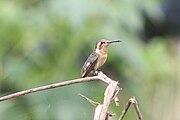Chaetocercus
Appearance
| Chaetocercus | |
|---|---|

| |
| Female gorgeted woodstar (Chaetocercus heliodor) | |
| Scientific classification | |
| Domain: | Eukaryota |
| Kingdom: | Animalia |
| Phylum: | Chordata |
| Class: | Aves |
| Clade: | Strisores |
| Order: | Apodiformes |
| Family: | Trochilidae |
| Tribe: | Mellisugini |
| Genus: | Chaetocercus G.R. Gray, 1855 |
| Type species | |
| Ornismya jourdanii (rufous-shafted woodstar) Bourcier, 1839
| |
| Synonyms | |
| |
Chaetocercus is a genus of hummingbirds in the family Trochilidae.
Taxonomy
[edit]The genus Chaetocercus was introduced in 1855 by the English zoologist George Robert Gray with the rufous-shafted woodstar as the type species.[1][2] The name is a combination of the Ancient Greek words khaitē, meaning "hair" and kerkos, meaning "tail".[3]
The genus contains six species:[4]
| Common name | Scientific name and subspecies | Range | Size and ecology | IUCN status and estimated population |
|---|---|---|---|---|
| White-bellied woodstar | Chaetocercus mulsant (Bourcier, 1843) |
Bolivia, Colombia, Ecuador, and Peru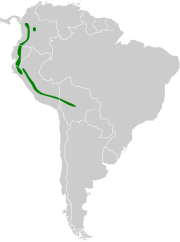
|
Size: Habitat: Diet: |
LC
|
| Little woodstar | Chaetocercus bombus Gould, 1871 |
Colombia, Ecuador and Peru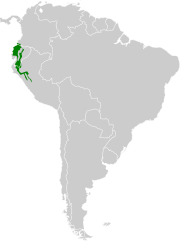
|
Size: Habitat: Diet: |
NT
|
| Gorgeted woodstar | Chaetocercus heliodor (Bourcier, 1840) Two subspecies
|
Colombia, Ecuador, and Venezuela
|
Size: Habitat: Diet: |
LC
|
| Santa Marta woodstar | Chaetocercus astreans (Bangs, 1899) |
Colombia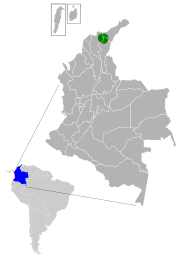
|
Size: Habitat: Diet: |
LC
|
| Esmeraldas woodstar | Chaetocercus berlepschi (Simon, 1889) |
Ecuador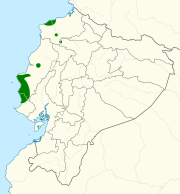
|
Size: Habitat: Diet: |
VU
|
| Rufous-shafted woodstar
|
Chaetocercus jourdanii (Bourcier, 1839) Three subspecies
|
Colombia, Trinidad and Tobago, and Venezuela.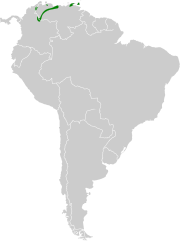
|
Size: Habitat: Diet: |
LC
|
All these species, except for the rufous-shafted woodstar, were formerly placed in the genus Acestrura.[5] In 1999 Karl-Ludwig Schuchmann remarked in the Handbook of the Birds of the World that for the species placed in Acestrura: "...no evidence in external morphology justifies treatment in a genus separate from C. jourdanii".[6]
References
[edit]- ^ Gray, George Robert (1855). Catalogue of the Genera and Subgenera of Birds Contained in the British Museum. London: British Museum. p. 22.
- ^ Peters, James Lee, ed. (1945). Check-List of Birds of the World. Vol. 5. Cambridge, Massachusetts: Harvard University Press. p. 140.
- ^ Jobling, James A. (2010). The Helm Dictionary of Scientific Bird Names. London: Christopher Helm. p. 98. ISBN 978-1-4081-2501-4.
- ^ Gill, Frank; Donsker, David; Rasmussen, Pamela, eds. (August 2022). "Hummingbirds". IOC World Bird List Version 12.2. International Ornithologists' Union. Retrieved 16 September 2022.
- ^ Peters, James Lee, ed. (1945). Check-List of Birds of the World. Vol. 5. Cambridge, Massachusetts: Harvard University Press. p. 139.
- ^ Schuchmann, K.L. (1999). "Genus Chaetocercus". In del Hoyo, J.; Elliott, A.; Sargatal, J. (eds.). Handbook of the Birds of the World. Vol. 5: Barn-owls to Hummingbirds. Barcelona, Spain: Lynx Edicions. p. 677. ISBN 978-84-87334-25-2.




